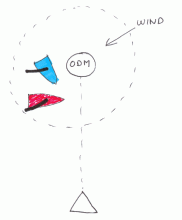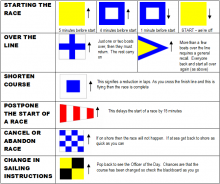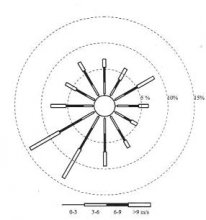The Racing Rules of Sailing
Top Tips for Gunfleet Racers no. 218
An understanding of the “Racing Rules of Sailing” adds to the enjoyment to be had from racing down at the Gunfleet and this little article provides a few helpful hints for both experienced and novice sailors.
Years ago – and I hope you’ll forgive me if I indulge in a little nostalgia here – it was very difficult to find out what the rules actually said. If you were serious about racing you bought the latest copy of Paul Elvstrom explains the Racing Rules. Inside the back cover of this pocket-sized book there were little plastic boats (red and blue with a bit of wire to represent the boom) together with little plastic marks and a plastic arrow with “wind” written on it. You could play for hours. If ever you attended a Protest Committee you would find that everyone had their own copy of this classic little book.
Now for those under the age of forty let me explain that Paul Elvstrom (known as “the Great Dane”) was the foremost dinghy sailor of his generation, and perhaps the greatest sailor of all time. His ability to explain the yacht racing rules was however more modest. Consequently the Rules remained shrouded in a certain mystique. Certainly I never saw a copy of the actual rules, only Paul Elvstrom’s interpretation of them.
I’m pleased to report however that things have got better. Information is much more readily available than it was and the world is a more democratic place. Just look it up on the web and you can download a copy of the Rules for free. Go to the ISAF website www.isaf.com and search for “Racing Rules of Sailing”.
For older readers I should explain that ISAF is the International Sailing Federation which was formerly known as the IYRU (International Yacht Racing Union).The name was changed in 1996 apparently, though I don’t know why they decided to put in the extra “A” . The Rules are updated every four years and the current set is the 2005-2008 rules.
Now you might imagine that the Rules are very complicated and run into several hundred pages. Actually this is not so. The PDF file for which I have given you the link is about 180 pages long, but most of these pages consist of obscure detail (what sort of sponsorship you are allowed on the sail, banned substances, fog signals and so on). The basic rules occupy less than ten pages and the fundamental rules can be written down on the back of an envelope (or for the less politically correct, the back of a fag packet).
The rules do evolve over time. One such change relates to the rounding of marks. The fundamental rule is that:-
when boats are overlapped the outside boat shall give the inside boat room to round or pass the mark or obstruction. [Rule 18.2(a)].
The definition of an “overlap” used to be very complicated. If I may digress into a flight of fancy for a moment, years ago when you went to a regatta you would always encounter a character called “Master Beam”. Lots of people obviously knew him, though I never met him personally, nor his sister Miss Beam or any other member of the Beam family. However it seemed that when you approached a mark the helms of competing boats would shout out “Master Beam! Master Beam!” as if to attract his attention. Well, as I say, I never actually met him and it seems that he has disappeared from the scene. Nowadays the definition of an overlap is much simpler.
Clear Astern and Clear Ahead; Overlap One boat is clear astern of another when her hull and equipment in normal position are behind a line abeam from the aftermost point of the other boat’s hull and equipment in normal position. The other boat is clear ahead. They overlap when neither is clear astern. However, they also overlap when a boat between them overlaps both. Definitions, page 169)
So to emphasise, if an overlap occurs in the “zone” (two boat lengths of the mark) then the inside boat must give the outside boat room. However (and this is important for Gunfleet sailors) this rule does not apply at the ODM at the start of a race. Because we have a fixed start line (rather than a committee boat start where the line is always at 90 degrees to the wind) the outer end of the Gunfleet start line can get quite crowded when the wind is S or SW. Everyone wants to be approaching the seaward end of the line at full speed when the starting signal sounds. Have a look at the diagram, which describes the situation just moments before the start. The red boat is close hauled (beating) and will clear the mark. Does she have to give the blue boat room to round the starting mark? The answer is no. Although they are within two boat lengths of the mark, rule 18 (room to round a mark) does not apply. I could give you chapter and verse but it’s common sense really. Download the rules and work it out for yourself. If the blue boat could legitimately claim water for the mark then it would be in everyone’s interest to just “push in” and it would be chaos (or more chaotic than usual). If you are in any doubt, the correct procedure in such a situation is for the red boat to say firmly “No water given” (but in a friendly Gunfleet fashion).
Of course in the situation described in the diagram you could always try starting on starboard. You would have then have right of way over all the port tack boats.
AD




